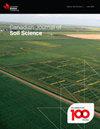Effects of increasing soil pH to near-neutral using lime on phosphorus saturation index and water-extractable phosphorus
IF 1.5
4区 农林科学
Q4 SOIL SCIENCE
引用次数: 2
Abstract
Abstract We studied the effects of liming to increase soil pH from acidic to near-neutral on the degree of phosphorus saturation (DPS), the P saturation index (PSI), Mehlich-3 P (PM3), and water-extractable P (Pw). Soils collected from a long-term highbush blueberry experiment were incubated at 22.5 °C for 93 days after CaCO3 amendment to increase pH values from 4.1, 4.8, and 5.5 to 6 and from 5.8 to 6.5. Liming decreased PM3 by 8%, 6%, 10%, and 11% with increasing initial soil pH. The PM3 concentrations of all the studied soils belonged to the very high class with critical DPS > 25%, which are associated with increased environmental risk of P loss with runoff. For soils with initial pH values of 5.8, Pw was 3.65 mg kg–1, in line with critical DPS > 25%, but decreased to 2.74 mg kg–1 with CaCO3 addition. In contrast, soils with initial pH < 5.5 had lower Pw concentrations and CaCO3 did not significantly decrease Pw at the end of the incubation averaging 1.02, 1.11, and 1.43 mg kg–1 for initial pH 4.1, 4.8, and 5.5, respectively. The low Pw concentrations of soils with initial pH < 5.5 were in line with low PSI (5.2%–6.1%), but did not reflect DPS values > 25%. It is possible that high exchangeable aluminum (Al) (AlM3 > 2500 mg kg–1) enhanced the fixation of phosphate ions from the soil solution, thus reducing Pw. Our results suggest that using PM3 as a sole indicator of environmental risk likely underestimates potential P losses compared with Pw. Résumé Les auteurs ont étudié les effets du chaulage utilisé pour neutraliser le pH d’un sol acide i) sur le taux de saturation du P (TSP), l’indice de saturation du P (ISP), la teneur en P selon la technique Mehlich-3 (PM3) et la teneur du P extractible à l’eau P (Pw). Des échantillons de sol venant d’une expérience de longue haleine sur le bleuet en corymbe ont été incubés pendant 93 jours à 22,5 °C après avoir été amendés avec du CaCO3 de façon à augmenter le pH de 4,1, 4,8 ou 5,5 à 6 et de 5,8 à 6,5. Le chaulage diminue la concentration de PM3 de 8, 6, 10 et 11 %, selon le pH du sol de plus en plus élevé. Dans tous les sols examinés, la concentration de PM3 se retrouve dans la classe la plus élevée, avec un TSP supérieur à 25 %, associé à un risque plus grand de lixiviation par le ruissellement. Pour les sols dont le pH initial était de 5,8, la concentration de Pw s’établissait à 3,65 mg par kg, ce qui est cohérent avec un TSP critique de plus de 25%, mais l’addition de CaCO3 ramène la concentration à 2,74 mg par kg. En revanche, les sols au pH inférieur à 5,5 au départ se caractérisaient par une concentration inférieure de Pw qui n’avait pas été affectée de manière significative par le CaCO3 à la fin de la période d’incubation (concentration moyenne de 1,02, 1,11 et 1,43 mg par kg pour un pH initial de 4,1, 4,8 ou 5,5, respectivement). La faible concentration de Pw observée dans les sols dont le pH initial était inférieur à 5,5 est cohérente avec le faible ISP (de 5,2 à 6,1 %), mais pas avec un TSP inférieur à 25 %. Il se peut qu’une concentration élevée d’aluminium facilement échangeable (AlM3 > 2 500 mg par kg) ait accru la fixation des ions phosphate dans la solution de sol, ce qui a réduit la concentration de Pw. Ces résultats laissent croire que, contrairement à ce qui se produit quand on utilise la concentration de Pw, on sous-estime sans doute les pertes potentielles de P quand on ne se sert que de la concentration de PM3 comme indicateur des risques environnementaux. [Traduit par la Rédaction]石灰提高土壤pH值至接近中性对磷饱和指数和水溶性磷的影响
摘要研究了石灰处理使土壤pH由酸性提高到接近中性对土壤磷饱和度(DPS)、磷饱和指数(PSI)、mehlich - 3p (PM3)和水可萃取磷(Pw)的影响。长期高丛蓝莓试验土壤经CaCO3修正后,在22.5°C下培养93 d,将pH值从4.1、4.8和5.5提高到6,从5.8提高到6.5。随着土壤初始ph的增加,施用石灰可使PM3降低8%、6%、10%和11%。所有研究土壤的PM3浓度均属于非常高级别,临界DPS >为25%,这与P随径流流失的环境风险增加有关。对于初始pH值为5.8的土壤,Pw为3.65 mg kg-1,符合临界DPS > 25%,但添加CaCO3后Pw降至2.74 mg kg-1。相比之下,初始pH < 5.5的土壤的Pw浓度较低,CaCO3在孵育结束时对Pw的影响不显著,初始pH为4.1、4.8和5.5时,Pw的平均值分别为1.02、1.11和1.43 mg kg-1。初始pH < 5.5土壤的低Pw浓度与低PSI(5.2% ~ 6.1%)一致,但不反映DPS值> 25%。高交换性铝(Al) (AlM3 > 2500 mg kg-1)可能增强了土壤溶液中磷酸盐离子的固定,从而降低了Pw。我们的研究结果表明,与Pw相比,使用PM3作为环境风险的唯一指标可能低估了潜在的P损失。简历里面的导演我们Les运用du chaulage利用倒缓冲器le pH值d一个索尔现在我)关于taux de饱和du P (TSP), l 'indice de饱和du P (ISP),洛杉矶teneur en P根据拉技术Mehlich-3(量子)等杜拉teneur P可提取的威尼斯P (Pw)。Des样品在一个体验德·德·索尔文南长时日苏尔le bleuet en corymbe安大略省的高频incubes吊坠93天时间22日5°C然后得到高频修改用du碳酸钙德这样一个增压器勒德4 pH值,1、4、8欧5、5一6 et de 5 6 8例,5。充液可使PM3 de 8、6、10和10的浓度降低11%,并可使pH du sol de + en + samevevest降低11%。Dans tous les sols examinsamas, la concentration de PM3 se retrouve Dans la classe la + samlevsame, avec untsp supsamrieur, 25%, associ unrisque + grand de lixiation, parle ruisselement。倒les溶胶不让pH初始化的caco_3的浓度为5、8,paco_3的浓度为3、65 mg / kg, paco_3的浓度为3、65 mg / kg, paco_3的浓度为2、74 mg / kg。在pH值为4、1、4、8、5和5的初始条件下,pH值为1、2、1、11和1、43 mg / kg的初始pH值分别为1、2、1、4、8和5、5的条件下,pH值为1、2、1、4、8和5、5的条件下,对pH值为5、5、5的条件下,CaCO3 / 3的浓度对pH值为5、5、5的条件下的CaCO3 / 3的浓度影响显著。Pw观测到的有效浓度与Pw观测到的有效浓度相比,Pw初始的samsamet和samsamet均低于Pw初始的samsamet和samsamet初始的samsamet和samsamet初始的samsamet和samsamet初始的samsamet和samet初始的samet和samet初始的samet和samet初始的samet和samet初始的samet和samet初始的samet和samet初始的samet和samet初始的samet和samet初始的samet和samet初始的samet和samet初始的samet和samet初始的samet。将peut qu 'une浓度与铝催化剂(AlM3 > 2 500 mg / kg)的混合物混合在一起,然后将其固定在磷酸盐溶液中,然后将其与Pw的浓度混合在一起。这些指标包括:质量指标、产品指标、利用指标、空气质量指标、空气质量指标、空气质量指标、空气质量指标、空气质量指标、环境风险指标。[贸易协定]
本文章由计算机程序翻译,如有差异,请以英文原文为准。
求助全文
约1分钟内获得全文
求助全文
来源期刊

Canadian Journal of Soil Science
农林科学-土壤科学
CiteScore
2.90
自引率
11.80%
发文量
73
审稿时长
6.0 months
期刊介绍:
The Canadian Journal of Soil Science is an international peer-reviewed journal published in cooperation with the Canadian Society of Soil Science. The journal publishes original research on the use, management, structure and development of soils and draws from the disciplines of soil science, agrometeorology, ecology, agricultural engineering, environmental science, hydrology, forestry, geology, geography and climatology. Research is published in a number of topic sections including: agrometeorology; ecology, biological processes and plant interactions; composition and chemical processes; physical processes and interfaces; genesis, landscape processes and relationships; contamination and environmental stewardship; and management for agricultural, forestry and urban uses.
 求助内容:
求助内容: 应助结果提醒方式:
应助结果提醒方式:


